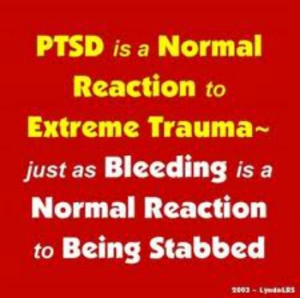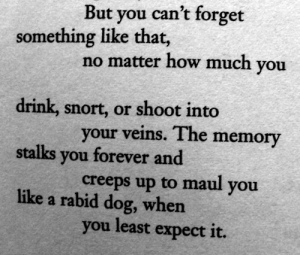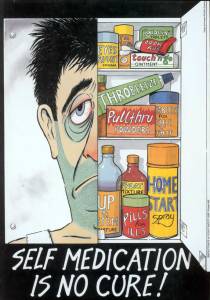When you get diagnosed with PTSD or suspect that you might have PTSD, it can be a difficult pill to swallow. You will most likely have a lot of questions or are at lost for what to do next.
Maybe you think that you are crazy. Maybe you feel ashamed. Even a little shocked. That’s normal. Give yourself some time to adjust.
Let me tell you this (and this might seem strange to you): Being diagnosed with PTSD isn’t the end of the world. In fact, it’s a good thing! Not that you have PTSD obviously, but at least now you finally know what’s causing your stress, anxiety and all the other stuff that’s been thrown at you. And now you know what you are up against, you can start to deal with it. You are not your diagnosis! Remember that.
Tip 1: Educate yourself!
It’s important to know as much as you can about what it is you are battling. It will make the fight easier and you will understand yourself, your actions and reactions better.
Search the web for information, talk to others who have PTSD or read books about the subject.
You can also start with reading this article on my blog: Battling A Memory Monster.
There are different types of Traumatic disorders and it’s useful to know which type you are dealing with.
All types have these 3 main group of symptoms:
1.Re-experiencing the traumatic event
2.Avoiding reminders of the trauma
3.Increased anxiety and emotional arousal
ASD: Acute Stress Disorder.
This type will occur right after the traumatic event happened. It comes with a lot of the same symptoms as PTSD, but it will usually last for 1 to 3 months. If treated early and in the right way, you may avoid developing full blown PTSD.
PTSD: Post Traumatic Stress Disorder.
To get diagnosed with PTSD, the symptoms must still be present after 10 months after the traumatic event. If not treated or recognized, it can evolve in Chronic PTSD.
Delayed PTSD: Delayed Post Traumatic Stress Disorder.
This type of traumatic disorder can develop many years after the traumatic event but for the diagnosis it has to be at least 6 months ago. This type develops when someone gets stuck in ‘survival mode’ or when exposed to multiple traumatic events who follow up on each other.
C-PTSD: Complex Post Traumatic Stress Disorder.
May develop after being exposed to multiple traumatic events. Although this category is not formally recognized in diagnostic systems, there are many articles to find about this type.
Tip 2: Acceptance!
So, you are diagnosed with PTSD. That seriously sucks! But you have to know that you already were suffering from PTSD before you got diagnosed. Your struggles just have a name now. You are not crazy, there is nothing wrong with you and you are not responsible for it. The sooner you accept yourself with PTSD, the sooner you can start to heal.
Post-traumatic stress disorder (PTSD) can make you feel disconnected from others. You may be tempted to withdraw from social activities and your loved ones. It may seem easier to be just on your own. And although everyone needs some time and space on their own, do NOT push people away. Getting isolated is one of the worse things you can do.
It’s very important to stay connected to life and the people who care about you.
Tip 3: Reach Out!
Support from other people is vital to your recovery from PTSD, so ask your close friends and family members for their help during this tough time.
Also, there is absolutely no shame in reaching out for help from a psychiatrist. In fact, it’s vital in most cases.
There are different treatments for PTSD. Find out which one fits you best.
Cognitive-behavioral therapy for PTSD and trauma involves carefully and gradually “exposing” yourself to thoughts, feelings, and situations that remind you of the trauma. Therapy also involves identifying upsetting thoughts about the traumatic event–particularly thoughts that are distorted and irrational—and replacing them with more balanced picture.
Since PTSD affects both you and those close to you, family therapy can be especially productive. Family therapy can help your loved ones understand what you’re going through. It can also help everyone in the family communicate better and work through relationship problems caused by PTSD symptoms.
Medication is sometimes prescribed to people with PTSD to relieve secondary symptoms of depression or anxiety. Antidepressants such as Prozac and Zoloft are the medications most commonly used for PTSD. While antidepressants may help you feel less sad, worried, or on edge, they do not treat the causes of PTSD. In my opinion, medication should only be used if it’s necessary, because they don’t treat your PTSD.
EMDR (Eye Movement Desensitization and Reprocessing) incorporates elements of cognitive-behavioral therapy with eye movements or other forms of rhythmic, left-right stimulation, such as hand taps or sounds. Eye movements and other bilateral forms of stimulation are thought to work by “unfreezing” the brain’s information processing system, which is interrupted in times of extreme stress.
Tip 4: Avoid substance abuse!
When you’re struggling with difficult emotions and traumatic memories, you may be tempted to self-medicate with alcohol or drugs. But while alcohol or drugs may temporarily make you feel better, they make post-traumatic stress disorder (PTSD) worse in the long run. Substance use worsens many symptoms of PTSD, including emotional numbing, social isolation, anger, and depression. It also interferes with treatment and can add to problems at home and in your relationships.
People with PTSD are known to be vulnerable to addiction. After all, it’s always easier to avoid than to deal with the problem. Dealing with PTSD takes courage. We all have courage, we just need to find it sometimes. Don’t make it harder on yourself by fighting two battles instead of one.
You think that you can drown your PTSD? You can’t. Drugs and alcohol are not magic, they won’t make your PTSD go away.
Tip 5: Talk!
Probably the hardest thing to do is talk about what happened to you. But it’s one of the most important things too. Start small and don’t push yourself.
If talking about it is too hard, start by writing it down. The next step would be to let someone you trust read it. Talking about it after that will be easier because the person already knows a bit about your trauma and you won’t have to explain everything. Be prepared that talking can be a trigger and remember that things might get worse before they get better. Make sure that you are somewhere you feel safe and with someone who knows how to handle when you get a flashback or panic attack.
It’s okay to shut down in the middle of a conversation. Enough is enough. Recovery takes time.
Stay Strong & Keep Fighting!
Patty










Patty, I can see why you established “Never Howl Alone” ………So thorough, so comprehensive. I learned a lot, especially that there are by name pre & post types of PTSD. So worthy a contribution to reach out & help those in distress &, perhaps, not knowing why. Phil
LikeLike
Thank you Phil!
I sure hope that it will help people.
Hugz & Love ❤
LikeLike